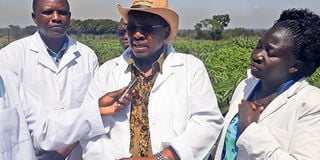Kalro upbeat as it develops improved cassava varieties

Kalro Director-General, Eliud Kireger during an inspection at the organisation's Alupe Station in Busia. Researchers at the station are banking on new cassava varieties to encourage alternative farming in the wake of reduced maize yields in the country. PHOTO | GAETANO PESSA | NMG
What you need to know:
- Lead scientist Douglas Miano, who is in charge of developing the tuber under VIRCA plus project at the Kalro Busia station, said the case for the uptake of the new varieties has been made strong by improved yields.
- He added that once the agency is given the green light by State regulators, it would be ready to release the seeds to farmers.
- The Kalro boss said there is a need for diversification, adding that the country should not rely on mainstream crops like maize, tea and sugarcane that have borne the brunt of erratic climatic conditions and low prices.
- Cassava is a staple food for many residents of Busia, Siaya, Kisumu, Homa Bay, Migori and several other counties in western Kenya.
Researchers are banking on new cassava varieties to encourage alternative farming in the wake of reduced maize yields in Kenya. Some high-yielding varieties recently developed include TME 2004, TME 14, Nasa 13 and Nasa 14.
These are in a pool of 30 cassava seed varieties that have also proved to be drought and disease and pest-resistant.
The Kenya Agricultural and Livestock Research Organisation (Kalro) says the varieties can withstand cassava brown streak and cassava mosaic, two diseases that drastically reduce harvests.
Lead scientist Douglas Miano, who is in charge of developing the tuber under VIRCA plus project at the Kalro Busia station, said the case for the uptake of the new varieties has been made strong by improved yields.
“The minimum we can get from these varieties is 30 tonnes of cassava per hectare. That is three times what a farmer gets from the traditional types,” Dr Miano said at the Kalro station in Alupe during an inspection.
“It means we can multiply production threefold by just managing diseases and pests.”
He added that once the agency is given the green light by State regulators, it would be ready to release the seeds to farmers.
“The zymogenic potential assessment cleared poisonous effects synonymous with some cassava varieties,” Dr Miano said.
“These varieties are not necessarily going to replace the ones farmers are growing but they will reduce incidents of food poisoning that arise from consuming raw cassava.”
PROCESSED INTO FLOUR
Some traditional cassava is known to have cyanide. Kalro Director-General Eliud Kireger, however, said distributing the seeds to farmers could be delayed because the government has not lifted the 2012 ban on GM crops.
“The ban has affected our efforts. We hope it will soon be lifted to enable Kenyan farmers to get high-quality cassava seeds,” Dr Kireger said.
The Kalro boss said there is a need for diversification, adding that the country should not rely on mainstream crops like maize, tea and sugarcane that have borne the brunt of erratic climatic conditions and low prices.
“Cassava is a drought-resistant crop. Dried cassava can be processed into flour, which can be used for ugali, crisps, cakes and other foods. It can also be used in the pharmaceutical and beauty industries,” he said.
Dried cassava leaves can be fed to livestock and eaten as vegetables if prepared properly. Farmers and cassava processors alike lauded the development, saying it would revive the subsector that has been in rapid decline for the past two decades, a situation blamed on diseases and pests.
Tangakona Commercial Village processor official Catherine Otaga could not hide her excitement.
“Of the 1,000 tonnes of cassava we receive from local farmers, at least 200 kilogrammes are spoilt,” she said. “This is a loss to the farmers and processors. We need certified seeds that are high yielding to benefit the companies and growers.”
Cassava is a staple food for many residents of Busia, Siaya, Kisumu, Homa Bay, Migori and several other counties in western Kenya.
It is also popular in the Coast region and some northern counties. It can easily be produced by a low-income farmer.




